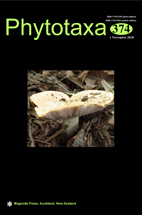Abstract
A new species (Comatricha macrospora) has been collected from the Changbai Mountain National Nature Reserve, Jilin Province, China. Comatricha macrospora has smaller sporocarps and larger spores (about 15–18 μm in diameter) than other species of Comatricha as well as a persistent peridium at the base of the sporotheca. In addition, two newly recorded species of Comatricha—C. tenerrima (M.A. Curtis) G. Lister and C. afroalpina Rammeloo—have been documented in China for the first time, based on material collected from northeast China and the campus of East China Normal University, Fuzhou City, Jiangxi Province. Comatricha tenerrima is characterised by fusiform long-stalked sporocarps and warted pinkish brown spores (about 7–8 μm in diameter)., whereas C. afroalpina occurs on rotting logs and has spores marked by larger warts with an irregular reticulation at their base. Descriptions and scanning electron micrographs for these members of the genus Comatricha are provided. Phylogenetic analyses, based on small subunit ribosomal RNA sequences (SSUrRNA) of Comatricha and related genera, were carried out using Bayesian inference. These analyses confirmed the placement of the new species in the genus Comatricha.

